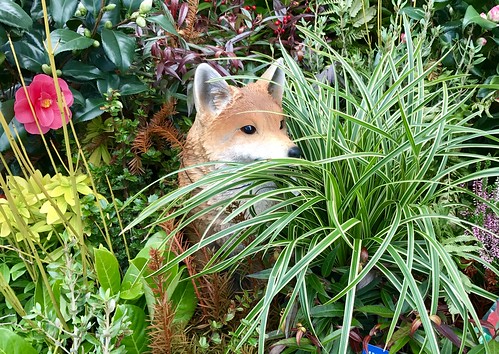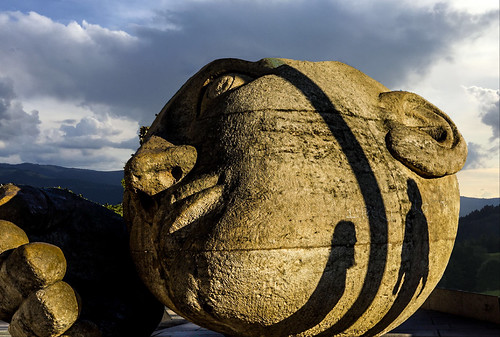
Out and about today I was intrigued by a display of Red Fox caricature’s posing in a manner displaying typical behaviour’s that the real life animal would demonstrate, doubting I will ever have the privilege to witness this personally, I took a few photos to archive on my Flickr.
The Red Fox (Vulpes vulpes) is a member of the Canidae family and is a part of the order Carnivora within the class of mammals.
Members of the family are called ‘canids’ and include dogs, wolves, foxes, coyotes, dingoes, jackals and African Wild Dogs.
The Red fox is the most widely distributed and populous canid in the world, having colonised large parts of Europe, America, Asia and Africa. In the British Isles, where there are no longer any other native wild canids, it is referred to simply as ‘the fox’. The Red Fox pre-breeding season population is estimated to be 258,000.
A male fox is called a ‘Dog’, a female fox is called a ‘Vixen’, a young fox is called either a ‘Kit’, ‘Pup’ or ‘Cub’. A group of foxes is called a ‘Skulk’.
RED FOX DESCRIPTION
As the name suggests, red foxes have rusty reddish-brown fur. This can vary in colouration and can give rise to black, silver or cross morphs. Their long, bushy tail, known as a ‘brush’ or ‘sweep’ is often tipped with white fur and the backs of the ears are black, as are part of the legs. They have white underparts.
During the autumn and winter, the Red Fox will grow more fur. This so called ‘winter fur’ keeps the animal warm in colder environments. The fox sheds this fur at the beginning of spring, reverting back to the short fur for the duration of the summer.
Although foxes are the smallest members of the dog family, the largest species of Red fox may reach an adult weight of 3 – 11 kilograms (6.5 – 24 pounds). The average head and body length is 18 to 33.75 inches (46 to 86 centimetres), with a tail length of 12 to 21 inches (30.5 to 55 centimetres). The size of a fox can be estimated from their tracks. Red fox footprints are normally about 4.4 centimetres wide and 5.7 centimetres long. A normal trotting stride is about 33 – 38 centimetres. Size can vary from country to country, foxes living in Canada and Alaska tend to be larger than foxes in the Britain, which are in turn larger than those inhabiting the Southern United States.
The fox has a slender muzzle, with white fur on the top lip and some individuals have black tear marks. Their chest is often white.
Foxes have strong legs which allow them to reach speeds of approximately 48 kilometres per hour (30 miles per hour), a great benefit to catching prey or escaping from predators.
The spacing between the canine teeth of a fox is approximately 18 to 25 millimetres apart. Foxes lack the facial muscles necessary to bare their teeth, unlike most other canids.
RED FOX HABITATS
The fox is a remarkably resourceful creature, able to cope in a very wide range of different environmental conditions, from sub-tropical regions to icy tundra, the red fox is able to find food and keep warm. Foxes inhabit almost every habitat – sea cliffs, sand dunes, salt marshes, peat bogs, high mountains, woodland and particularly abundant in urban areas. They make ‘lairs’ in a foxes ‘earth’, under tree trunks, in hollow trees, in bracken or in a deserted buzzard nests.
RED FOX DIET
Red foxes are mainly carnivores but are generally classed as omnivores. In Britain, the red fox feeds mainly on small rodents such as field mice, voles and rabbits, however, they will also eat birds, insects, earthworms, grasshoppers, beetles, blackberries, plums and mollusks and crayfish, amphibians, small reptiles and fish. almost anything it finds, often eating carrion (dead animal carcass) or preying on new-born lambs in the spring. Foxes have also been known to kill deer fawns.
Foxes typically eat 0.5 – 1 kilograms (1 – 2 pounds) of food a day. With their acute sense of hearing, they can locate small mammals in thick grass and they are able to jump high in the air to pounce on the prey. This resourcefulness is one of the main reasons they have been able to populate our towns and cities with great success.
Foxes are superb hunters, able to sprint, turn and jump with surprising ease for a dog. Surplus food is buried, they typically store the food in shallow holes (5 – 10 centimetres deep). This is thought to prevent the loss of their entire food supply in the event that another animal finds the store.
RED FOX BEHAVIOUR
Living as it does in a wide variety of habitats, the fox displays a wide variety of behaviours. Two populations of the fox may be as different as two different species in their behaviour.
The Red Fox is primarily crepuscular with a tendency to becoming nocturnal in areas of great human interference, this means it is most active at night and at twilight. Foxes are generally solitary hunters, foraging alone in the summer, however, they very occasionally group together in a pack. In general, each fox claims its own territory and it pairs up only in winter. Territories may be as large as 50 kilometres squared (19 square miles), however, in habitats with abundant food sources, ranges are much smaller, less than 12 kilometres squared (4.6 square miles).
Several dens are utilized within these territories. Dens may be newly dug out or claimed from previous residents such as marmots. A larger main den is used for winter living, birthing and rearing of young, whereas smaller dens are dispersed throughout the territory for emergency and food storage purposes.
A series of tunnels often connects them with the main den. One fox may only need a square kilometre of land marked by recognition posts that are special smells that come from a scent gland located just above their tail.
Socially, the fox communicates with body language and a variety of vocalizations. Its vocal range is quite large and its noises vary from a distinctive three-yip ‘lost call’ to a shriek reminiscent of a human scream. It also communicates with scent, marking food and territorial boundary lines with urine and faeces.
RED FOX REPRODUCTION
The mating season is December to February when the female fox (vixen) can be heard at night uttering her eerie, high pitched scream. The Foxes primarily form monogamous pairs each winter. The pair stay together to act as parents to the new born kits (cubs or pups) after a gestation period of between 51 and 53 days.
Posted by DanoAberdeen on 2017-02-17 19:36:54
Tagged: , cub , pup , skulk , reynard , dog , vixen , conservation , natur , autumn , summer , spring , male , female , snooping , countryside , dano , wildlife , nature , foxs , fox , red fox , stray , coat , fur , wild , carnivora , species , canidae , kits , hunter , hunted , hun , litter , cute , cuteness , burrow , sniff , sniffing , bushy , bush , barking , bark , omnivore , predator , rabies , iphone , iphone 7 plus , cameraphone , natural , resources , heritage , cultural , soil , zoo , park , environment , bitch







